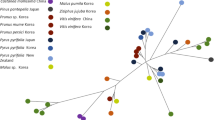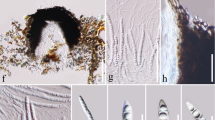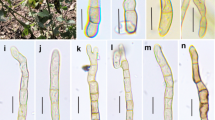Abstract
Fusarium is a large, complex genus that causes a wide variety of plant diseases, produces a number of mycotoxins and is becoming increasingly recognized as a significant human pathogen. These fungi occur in ecosystems in all parts of the globe, which makes them useful as a model to better understand biogeographic processes affecting the distribution of fungi. Here we review the information available on the biogeography of different species and clades of Fusarium and some of the likely processes affecting dispersal and speciation.
Similar content being viewed by others
References
Adams AW (1955) Succisa pratensis Moench. J Ecol 43:709–718
Ainsworth GC, Bisby GR, Kirk PM, Bioscience C (2001) Ainsworth & Bisby’s dictionary of the fungi / by P.M. Kirk ... [et al.]; with the assistance of A. Aptroot ... [et al.]. CABI, Wallingford
Akinsanmi OA, Backhouse D, Simpfendorfer S, Chakraborty S (2006) Genetic diversity of Australian Fusarium graminearum and F. pseudograminearum. Plant Pathol 55:494–504
Amata R, Burgess L, Summerell B, Bullock S, Liew E, Smith-White J (2010) An emended description of Fusarium brevicatenulatum and F. pseudoanthophilum based on isolates recovered from millet in Kenya. Fungal Divers 43:11–25
Aoki T, Nirenberg H (1999) Fusarium globosum from subtropical Japan and the effect of different light conditions on its conidiogenesis. Mycoscience 40:1–9
Aoki T, O’Donnell K, Homma Y, Lattanzi AR (2003) Sudden-death syndrome of soybean is caused by two morphologically and phylogenetically distinct species within the Fusarium solani species complex—F. virguliforme in North America and F. tucumaniae in South America. Mycologia 95:660–684
Avise JC (2000) Phylogeography: the history and formation of species. London Harvard University Press, Cambridge
Baayen RP, O’Donnell K, Bonants PJM, Cigelnik E, Kroon L et al (2000) Gene genealogies and AFLP analyses in the Fusarium oxysporum complex identify monophyletic and nonmonophyletic formae speciales causing wilt and rot disease. Phytopathology 90:891–900
Backhouse D, Burgess LW, Summerell BA (2001) Biogeography of Fusarium. In: Summerell BA, Leslie JF, Backhouse D, Bryden W, Burgess LW (eds) Fusarium. The American Phytopathology Society, Minnesota, pp 122–137
Beheregaray LB (2008) Twenty years of phylogeography: the state of the field and the challenges for the Southern Hemisphere. Mol Ecol 17:3754–3774
Bentley AR, Petrovic T, Griffiths SP, Burgess LW, Summerell BA (2007) Crop pathogens and other Fusarium species associated with Austrostipa aristiglumis. Australas Plant Pathol 36:434–438
Bentley AR, Summerell BA, Burgess LW (2008) Sexual compatibility in Fusarium pseudograminearum (Gibberella coronicola). Mycol Res 112:1101–1106
Bentley AR, Milgroom MG, Leslie JF, Summerell BA, Burgess LW (2009) Spatial aggregation in Fusarium pseudograminearum populations from the Australian grain belt. Plant Pathol 58:23–32
Booth C (1971) The genus Fusarium. Commonwealth Mycological Institute, Kew
Bowden RL, Leslie JF (1999) Sexual recombination in Gibberella zeae. Phytopathology 89:182–188
Britz H, Steenkamp ET, Coutinho TA, Wingfield BD, Marasas WFO, Wingfield MJ (2002) Two new species of Fusarium section Liseola associated with mango malformation. Mycologia 94:722–730
Burgess L, Backhouse D, Summerell BA, Swan LJ (2001) Crown rot of wheat. In: Summerell BA, Leslie JF, Backhouse D, Bryden W, Burgess LW (eds) Fusarium: Paul E. Nelson memorial symposium. APS Press, St Paul, pp 271–294
Carter LLA, Leslie JF, Webster RK (2008) Population structure of Fusarium fujikuroi from California rice and water grass. Phytopathology 98:992–998
Desjardins AE (2003) Gibberella from A (venaceae) to Z (eae). Annu Rev Phytopathol 41:177–198
Desjardins AE (2006) Fusarium mycotoxins: chemistry, genetics and biology. APS, St. Paul
Desjardins AE, Plattner RD, Gordon TR (2000) Gibberella fujikuroi mating population A and Fusarium subglutinans from teosinte species and maize from Mexico and Central America. Mycol Res 104:865–872
Farr DF, Bills GF, Chamuris GP, Rossman AY (1989) Fungi on plants and plant products in the United States. American Phytopathological Society Press, St Paul
Fries E (1821) Systema mycologicum 1. Mauritius, Gryphiswaldae
Gerlach W, Nirenberg H, Biologische Bundesanstalt für Land- und F (1982) The genus Fusarium: a pictorial atlas. Kommissionsverlag P. Parey, Berlin
Gordon TR, Martyn RD (1997) The evolutionary biology of Fusarium oxysporum. Annu Rev Phytopathol 35:111–128
Kerenyi Z, Moretti A, Waalwijk C, Olah B, Hornok L (2004) Mating type sequences in asexually reproducing Fusarium species. Appl Environ Microbiol 70:4419–4423
Kirk PM, Ainsworth GC, Bisby GR, International C.A.B (2008) Ainsworth & Bisby’s dictionary of the fungi. CABI, Wallingford
Kochman JK (1995) Fusarium wilt in cotton—a new record in Australia. Australas Plant Pathol 24:74
Kvas M, Marasas WFO, Wingfield BD, Wingfield MJ, Steenkamp ET (2009) Diversity and evolution of Fusarium species in the Gibberella fujikuroi complex. Fungal Divers 34:1–21
Lee T, Oh DW, Kim HS, Lee J, Kim YH et al (2001) Identification of deoxynivalenol- and nivalenol-producing chemotypes of Gibberella zeae by using PCR. Appl Environ Microbiol 67:2966–2972
Lee J, Chang IY, Kim H, Yun SH, Leslie JF, Lee YW (2009) Genetic diversity and fitness of Fusarium graminearum populations from rice in Korea. Appl Environ Microbiol 75:3289–3295
Leslie JF (1991) Mating populations in Gibberella fujikuroi (Fusarium section liseola). Phytopathology 81:1058–1060
Leslie JF (1995) Gibberella fujikuroi—available populations and variable traits. Can J Bot-Revue Canadienne De Botanique 73:S282–S291
Leslie JF, Klein KK (1996) Female fertility and mating type effects on effective population size and evolution in filamentous fungi. Genetics 144:557–567
Leslie JF, Summerell BA (2006) The Fusarium laboratory manual. Blackwell, Iowa
Leslie JF, Bowden RL (2008) Fusarium graminearum: when species concepts collide. Cereal Res Commun 36:609–615
Leslie JF, Zeller KA, Logrieco A, Mule G, Moretti A, Ritieni A (2004a) Species diversity of and toxin production by Gibberella fujikuroi species complex strains isolated from native Prairie Grasses in Kansas. Appl Environ Microbiol 70:2254–2262
Leslie JF, Zeller KA, Wohler M, Summerell BA (2004b) Interfertility of two mating populations in the Gibberella fujikuroi species complex. Eur J Plant Pathol 110:611–618
Lima CS, Pfenning LH, Costa SS, Campos MA, Leslie JF (2009) A new Fusarium lineage within the Gibberella fujikuroi species complex is the main causal agent of mango malformation disease in Brazil. Plant Pathol 58:33–42
Link HF (1809) Observationes in ordines plantarum naturals, Dissetatio I. Mag. Ges. Naturf. Freunde, Berlin 3:3–42
Ma LJ, van der Does HC, Borkovich KA, Coleman JJ, Daboussi MJ et al (2010) Comparative genomics reveals mobile pathogenicity chromosomes in Fusarium. Nature 464:367–373
Marasas WFO, Rabie CJ, Lubben A, Nelson PE, Toussoun TA, Vanwyk PS (1987) Fusarium napiforme, a new species from millet and sorghum in Southern-Africa. Mycologia 79:910–914
Matuo T, Snyder WC (1973) Use of morphology and mating populations in identification of formaespeciales in Fusarium solani. Phytopathology 63:562–565
Mayr E (1940) Speciation phenomena in birds. Am Nat 74:249–278
Mayr E (1963) Animal species and evolution. Harvard University Press, Cambridge
Nelson PE, Toussoun TA, Marasas WFO (1983) Fusarium species: an illustrated manual for identification. Pennsylvania State University Press, University Park
Nirenberg HI, O’Donnell K (1998) New Fusarium species and combinations within the Gibberella fujikuroi species complex. Mycologia 90:434–458
Nirenberg HI, O’Donnell K, Kroschel J, Andrianaivo AP, Frank JM, Mubatanhema W (1998) Two new species of Fusarium: Fusarium brevicatenulatum from the noxious weed Striga asiatica in Madagascar and Fusarium pseudoanthophilum from Zea mays in Zimbabwe. Mycologia 90:459–463
Nyvall R (1999) Field crop diseases. Iowa State University Press, Ames
O’Donnell K (2000) Molecular phylogeny of the Nectria haematococca Fusarium solani species complex. Mycologia 92:919–938
O’Donnell K, Cigelnik E, Nirenberg HI (1998a) Molecular systematics and phylogeography of the Gibberella fujikuroi species complex. Mycologia 90:465–493
O’Donnell K, Kistler HC, Cigelnik E, Ploetz RC (1998b) Multiple evolutionary origins of the fungus causing Panama disease of banana: concordant evidence from nuclear and mitochondrial gene genealogies. Proc Natl Acad Sci USA 95:2044–2049
O’Donnell K, Kistler HC, Tacke BK, Casper HH (2000) Gene genealogies reveal global phylogeographic structure and reproductive isolation among lineages of Fusarium graminearum, the fungus causing wheat scab. Proc Natl Acad Sci USA 97:7905–7910
O’Donnell K, Ward TJ, Geiser DM, Kistler HC, Aoki T (2004) Genealogical concordance between the mating type locus and seven other nuclear genes supports formal recognition of nine phylogenetically distinct species within the Fusarium graminearum clade. Fungal Genet Biol 41:600–623
Ploetz RC (1990) Fusarium wilt of banana. APS, St. Paul
Ploetz RC (2006) Fusarium induced diseases of tropical, perennial crops. Phytopathology 96:648–652
Qu B, Li HP, Zhang JB, Huang T, Carter J et al (2008) Comparison of genetic diversity and pathogenicity of Fusarium head blight pathogens from China and Europe by SSCP and seedling assays on wheat. Plant Pathol 57:642–651
Rheeder JP, Marasas WFO, Nelson PE (1996) Fusarium globosum, a new species from corn in southern Africa. Mycologia 88:509–513
Rosewich UL, Pettway RE, Katan T, Kistler HC (1999) Population genetic analysis corroborates dispersal of Fusarium oxysporum f. sp. radicis-lycopersici from Florida to Europe. Phytopathology 89:623–630
Rossman AY (1996) Morphological and molecular perspectives on systematics of the Hypocreales. Mycologia 88:1–19
Rossman AY, Samuels GJ, Rogerson CT, Lowen R (1999) Genera of bionectriaceae, hypocreaceae and nectriaceae (Hypocreales, Ascomycetes). Stud Mycol 1–248
Samuels GJ, Nirenberg HI, Seifert KA (2001) Perithecial species of Fusarium. In: Summerell BA, Leslie JF, Backhouse D, Bryden W, Burgess LW (eds) Fusarium: Paul E. Nelson Memorial Symposium. APS, St Paul, pp 1–14
Sangalang AE, Burgess LW, Backhouse D, Duff J, Wurst M (1995) Mycogeography of Fusarium species in soils from tropical, arid and mediterranean regions of Australia. Mycol Res 99:523–528
Schmale DG, Leslie JF, Zeller KA, Saleh AA, Shields EJ, Bergstrom GC (2006) Genetic structure of atmospheric populations of Gibberella zeae. Phytopathology 96:1021–1026
Schroers H-J, O’Donnell K, Lamprecht SC, Kammeyer PL, Johnson S et al (2009) Taxonomy and phylogeny of the Fusarium dimerum species group. Mycologia 101:44–70
Snyder WC, Hansen HN (1940) The species concept in Fusarium. Am J Bot 27:64–67
Snyder WC, Hansen HN (1941) The species concept in Fusarium with reference to section Martiella. Am J Bot 28:738–742
Snyder WC, Hansen HN (1945) The species concept in Fusarium with reference to discolor and other sections. Am J Bot 32:657–666
Snyder WC, Hansen HN (1954) Variation and speciation in the genus Fusarium. Ann NY Acad Sci 60:16–23
Starkey DE, Ward TJ, Aoki T, Gale LR, Kistler HC et al (2007) Global molecular surveillance reveals novel Fusarium head blight species and trichothecene toxin diversity. Fungal Genet Biol 44:1191–1204
Steenkamp ET, Wingfield BD, Coutinho TA, Zeller KA, Wingfield MJ et al (2000) PCR-based identification of MAT-1 and MAT-2 in the Gibberella fujikuroi species complex. Appl Environ Microbiol 66:4378–4382
Stover R (1990) Fusarium wilt of bananas: some history and current status of the disease. In: Ploetz R (ed) Fusarium wilt of banana. APS, St. Paul, pp 1–9
Taylor JW, Berbee ML (2006) Dating divergences in the fungal tree of life: review and new analyses. Mycologia 98:838–849
Taylor JW, Jacobson DJ, Kroken S, Kasuga T, Geiser DM et al (2000) Phylogenetic species recognition and species concepts in fungi. Fungal Genet Biol 31:21–32
Waalwijk C, van der Lee T, de Vries I, Hesselink T, Arts J, Kema GHJ (2004) Synteny in toxigenic Fusarium species: the fumonisin gene cluster and the mating type region as examples. Eur J Plant Pathol 110:533–544
Walsh JL (2007) Fusarium species associated with savanna ecosystems in Australia: taxonomy, ecology and pathogenicity. PhD Thesis. University of Sydney, Sydney
Walsh J, Laurence M, Liew E, Sangalang A, Burgess L et al (2010) Fusarium: two endophytic novel species from tropical grasses of northern Australia. Fungal Divers
Wang B, Brubaker CL, Burdon JJ (2004) Fusarium species and Fusarium wilt pathogens associated with native Gossypium populations in Australia. Mycol Res 108:35–44
Windels CE (2000) Economic and social impacts of Fusarium head blight: changing farms and rural communities in the Northern Great Plains. Phytopathology 90:17–21
Wollenweber HW, Reinking OA (1935) Die Fusarien, ihre Beschreibung, Schadwirkung, und Bekampfung. Verlag Paul Parey, Berlin
Zeller KA, Bowden RL, Leslie JF (2003a) Diversity of epidemic populations of Gibberella zeae from small quadrats in Kansas and north Dakota. Phytopathology 93:874–880
Zeller KA, Summerell BA, Bullock S, Leslie JF (2003b) Gibberella konza (Fusarium konzum) sp. nov. from prairie grasses, a new species in the Gibberella fujikuroi species complex. Mycologia 95:943–954
Zeller KA, Bowden RL, Leslie JF (2004) Population differentiation and recombination in wheat scab populations of Gibberella zeae from the United States. Mol Ecol 13:563–571
Author information
Authors and Affiliations
Corresponding author
Additional information
Manuscript no. 11-15-J from the Kansas Agricultural Experiment Station, Manhattan.
Rights and permissions
About this article
Cite this article
Summerell, B.A., Laurence, M.H., Liew, E.C.Y. et al. Biogeography and phylogeography of Fusarium: a review. Fungal Diversity 44, 3–13 (2010). https://doi.org/10.1007/s13225-010-0060-2
Received:
Accepted:
Published:
Issue Date:
DOI: https://doi.org/10.1007/s13225-010-0060-2




